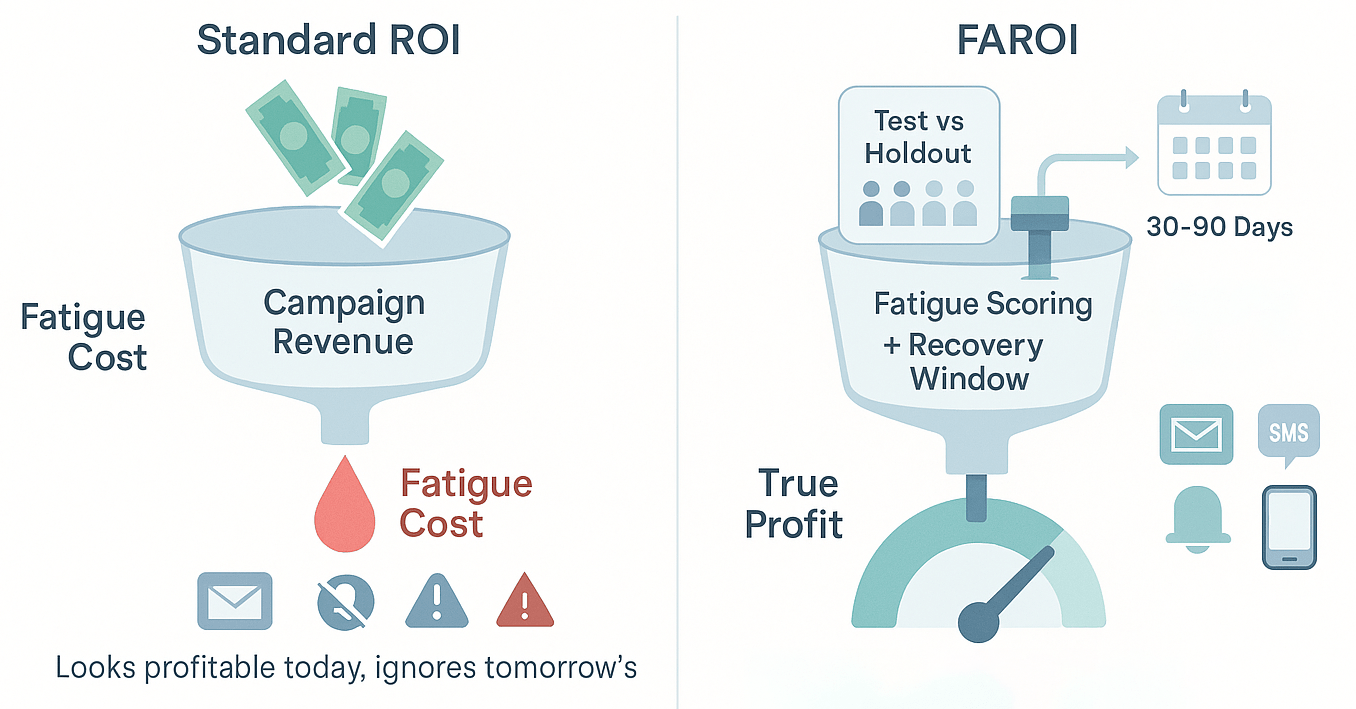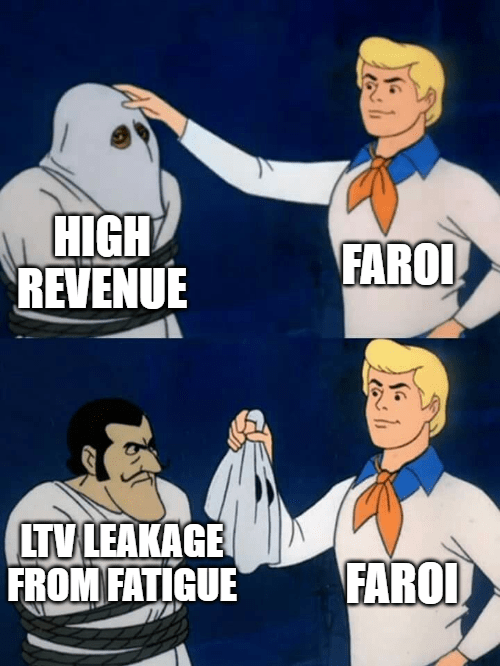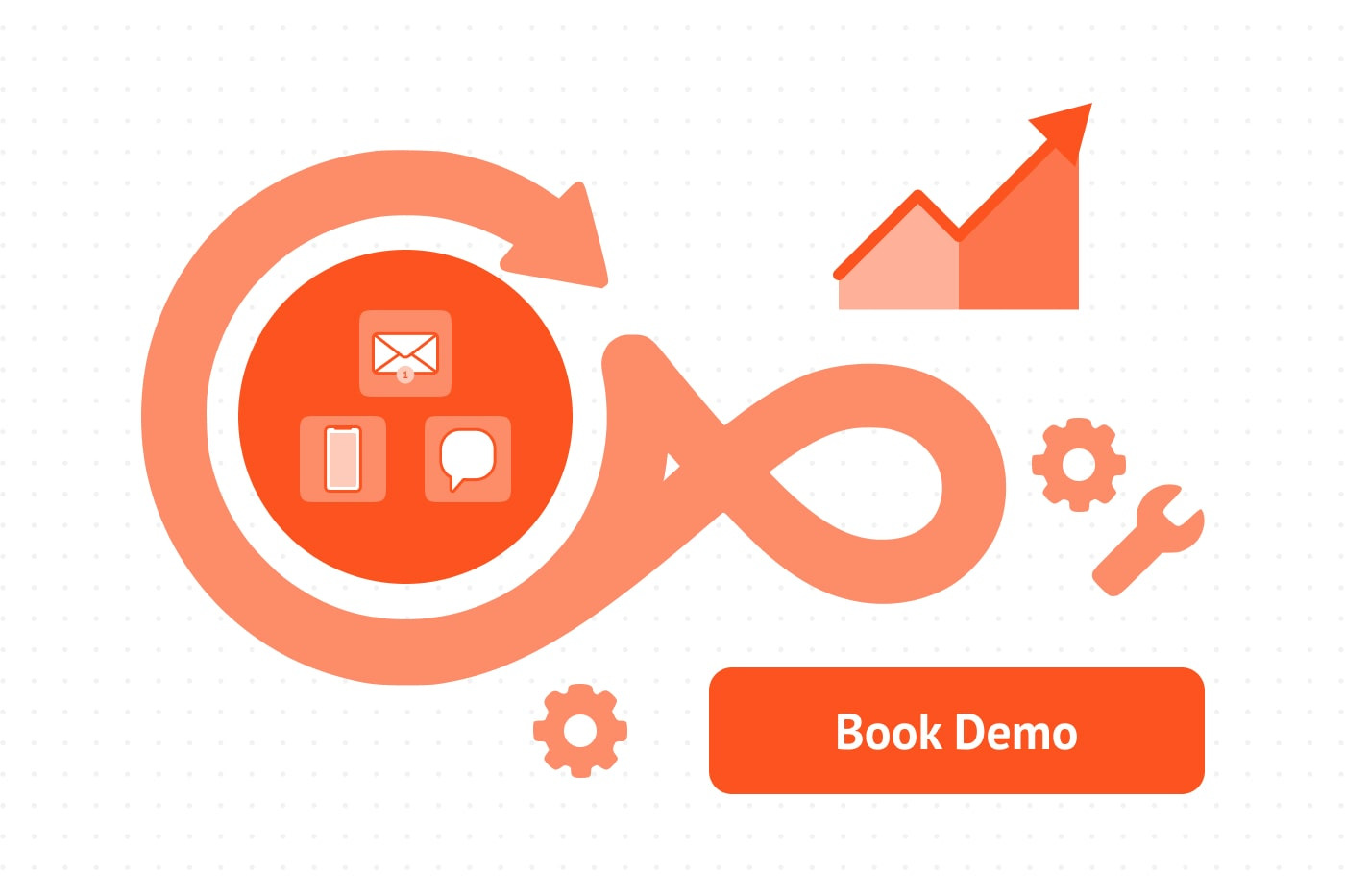
Alex Anikienko
Expert Writer
November 12, 2025

Alex Anikienko
Expert Writer
November 12, 2025

If you only analyze campaign return on investment (ROI), you’re probably overestimating profit, which can lead to inaccurate financial decisions. Standard ROI only considers the money you made today. However, fatigue-adjusted ROI (FAROI) also accounts for the money you’ll lose tomorrow when users mute pushes, unsubscribe from emails, or uninstall your app after receiving too many alerts. It helps you turn message fatigue from a gut feeling into actionable numbers for optimization.
This article is a practical add-on to Reteno’s deep dive on fatigue and frequency management. It explains the difference between standard ROI and FAROI, and provides a step-by-step guide on how to calculate this important metric for every push notification, email, or in-app message.

The core concern is messaging fatigue, which builds up over time. A single “noisy” campaign can trigger unsubscribes, notification opt-outs, and even product abandonment, hurting long-term engagement and LTV.
We highly recommend using a fatigue score to detect that risk early, slowing or pausing messaging for at-risk customer cohorts, and setting recovery windows to let users cool off. FAROI is the way to measure those protections in monetary value.
Standard ROI provides the answer to this question: “Did this campaign generate more revenue than it cost?”
The formula:
ROI = (Incremental Revenue – Direct Campaign Cost) ÷ Direct Campaign Cost
Fatigue-adjusted ROI answers the question: “Did this campaign generate more revenue than it cost after accounting for the value lost to fatigue (opt-outs, uninstalls, etc.)?”
The formula:
FAROI = (Incremental Revenue – Direct Campaign Cost – Fatigue Cost) ÷ Direct Campaign Cost
To calculate fatigue-adjusted returns, you need three main ingredients:
Incremental Revenue (IR): the extra money your campaign made compared to a control group (a random group of users who didn’t receive the message). It shows the true lift of your communication efforts, rather than just raw revenue.
Direct Campaign Cost (DC): the cost of running the campaign.
This includes:
Fatigue Cost (FC): the revenue you will lose in the future due to fatigue events triggered by the campaign. These are behaviors that reduce your ability to monetize users over time, including unsubscriptions, push opt-outs, and uninstalls.
While calculating FAROI is complex, it becomes easier when broken down into clear steps. The idea is to compare the extra revenue your campaign generates with both its direct costs and the hidden losses caused by messaging fatigue.
Follow these steps to transform raw campaign data into a clear, actionable number you can track over time.
Split your audience so that 10–20% of users do not receive the campaign (this is your control, or holdout, group). Compare the revenue from the test group that received the campaign to the holdout. The difference is your incremental revenue.
Include all sending costs, such as email, SMS, or push fees. Add in any creative or operational expenses that you typically have to cover. Don’t forget to include the value you gave away through discounts or offers. The total is your direct campaign cost.
Compare the test and control groups over the same time period (for example, 30 days).
As mentioned earlier, standard ROI looks at incremental revenue minus campaign costs. Fatigue-adjusted ROI considers incremental revenue minus both campaign costs and fatigue costs. Place the two results side by side. If the figures differ significantly, it means fatigue is eating into your future revenue.

Q: Do we really need a control group?
A: Yes, absolutely. Without a control, or holdout, group, “engagement lift” could just be a seasonal phenomenon. Holdouts make IR, and therefore FAROI, credible, and this credibility is essential for understanding the dynamics of the situation.
Q: We don’t track mutes or deliverability. Can we skip them?
A: Start with what you have: unsubs, opt-outs, uninstalls. Add email deliverability later. Even a small spike in complaints can negatively impact near-term revenue.
Q: What’s a good FAROI?
A: Calibrate this metric to your business. The point isn’t to have a universal number. Rather, the main objective is to ensure that “wins” still look like wins after accounting for messaging fatigue.
Traditional metrics look good on slides, but they hide the real leak: messaging fatigue that causes users to churn. Each time a user unsubscribes, opts out, or uninstalls, it silently cuts into customer lifetime value. That’s why fatigue-adjusted ROI is a must-have metric for your business. It provides a more accurate picture, the one your finance team and investors actually care about.
The real challenge is that calculating FAROI isn’t easy. You need randomized holdouts, fatigue tracking, and channel-specific LTV models. Doing this manually is slow, complex, and error-prone.
Reteno was designed to solve this exact challenge. Our platform:
With Reteno, you stop guessing. You see the true revenue of every campaign, protect user relationships, and scale profit sustainably.

Don’t wait until churn and opt-outs show up in your revenue reports. Select a Reeteno plan that meets your requirements or book a personalized demo today, and let our team show you how to put FAROI into action.
Alex Danchenko
|
October 4, 2022
Figure out how to calculate Customer Lifetime Value (CLV) and start working on it to increase your revenue
Alex Anikienko
|
June 18, 2025
See how AI messaging drives conversions and revenue by turning user behavior into real-time personalization

